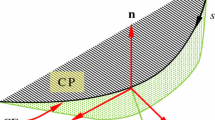Abstract
Crack size and structure size transitions are illustrated which connect the two limit-cases of ultimate tensile strength failure (small cracks and small structures) and mixed-mode crack propagation (large cracks and large structures). The problem of mixed-mode crack propagation in concrete is then faced. By increasing the size-scale of the element the influences of heterogeneity and cohesive crack tip forces disappear and crack branching is governed only by the linear elastic stress-singularity in the crack tip region. It is proved in this way that the fracture toughness of the material is measured by a unique parameter (GIF, GIC or KIC) even for the mixed-mode condition. The ratio of the sliding or Mode II fracture toughness (GIIF, GIIC or KIIC) to the opening or Mode I fracture toughness depends only on the crack branching criterion adopted and not on the material features. Eventually, very controversial experimental results recently obtained on the shear fracture of concrete are explained on the basis of the above-mentioned size-scale transition.
Similar content being viewed by others
References
Erdogan, F. and Sih, G. C., ‘On the crack extension in plates under plane loading and transverse shear,’J. Basic Engng 85 (1963) 519–527.
Nuismer, R. J., ‘An energy release rate criterion for mixed mode fracture,’Int. J. Fract. 11 (1975) 245–250.
Sih, G. C., ‘Some basic problems in fracture mechanics and new concepts,’Engng Fract. Mech. 5 (1973) 365–377.
Sih, G. C. and Macdonald, B., ‘Fracture mechanics applied to engineering problems—strain energy density fracture criterion,’ibid. 6 (1974) 361–386.
Carpinteri, A., Di Tommaso, A. and Viola, E., ‘Collinear stress effect on the crack branching phenomenon,’Mater. Struct. 12 (1979) 439–446.
Carpinteri, A., ‘Interpretation of the Griffith instability as a bifurcation of the global equilibrium’, in Proceedings of NATO-ARW Conference on Application of Fracture Mechanics to Cementitious Composites, Northwestern University, September 1984, edited by S. P. Shah (Nijhoff, 1985) pp. 287–316.
Carpinteri, A., Di Tommaso, A. and Fanelli, M., ‘Influence of material parameters and geometry on cohesive crack propagation’, in Proceedings of Conference on Fracture Toughness and Fracture Energy of Concrete, Lausanne, October 1985, edited by F. H. Wittmann (Elsevier, 1986) pp. 117–135.
Jenq, Y. S. and Shah, S. P., ‘Two parameter fracture model for concrete,’J. Engng Mech 111 (10) (1985). 1227–1241.
Idem. Jenq, Y. S. and Shah, S. P. ‘Mixed-mode fracture parameters for concrete’, in Proceedings of International Conference on Fracture Mechanics of Concrete and Rock, Houston, June 1987.
Carpinteri, A., ‘Static and energetic fracture parameters for rocks and concretes,’Mater. Struct. 14 (1981) 151–162.
Idem., ‘Notch sensitivity in fracture testing of aggregative materials,’Engng Fract. Mech. 16 (1982) 467–481.
Petersson, P. E., ‘Crack Growth and Development of Fracture Zones in Plain Concrete and Similar Materials’, Report TVBM-1006 (Division of Building Materials, Lund Institute of Technology Sweden, 1981).
Wecharatana, M. and Shah, S. P., ‘Prediction of nonlinear fracture process zone in concrete,’J. Engng Mech. 109 (1983) 1231–1246.
Ingraffea, A. R., ‘Non-linear fracture models for discrete crack propagation’, in Proceedings of NATO-ARW conference on Application of Fracture Mechanics to Cementitious Composites, Northwestern University, September 1984, edited by S. P. Shah (Nijhoff, 1985) pp. 247–285.
Bazant, Z. P., ‘Size effect in blunt fracture: concrete, rock, metal,’J. Engng Mech. 110 (1984) 518–535.
Carpinteri, A., ‘Stress-singularity and generalized fracture toughness at the vertex of re-entrant corners,’Engng Fract. Mech. 26 (1987) 143–155.
Arrea, M. and Ingraffea, A. R., ‘Mixed-mode Crack Propagation in Mortar and Concrete’. Report 81-13 (Department of Structural Engineering, School of Civil and Environmental Engineering, Cornell University, New York, 1981).
Ingraffea, A. R. and Panthaki, M. J., ‘Analysis of shear fracture tests of concrete beams’, in Proceedings of Seminar on Finite Element Analysis of Reinforced Concrete Structures, Tokyo, May 1985 (1985) pp. 71–91.
Bažant, Z. P. and Pfeiffer, P. A., ‘Shear fracture tests of concrete,’Mater. Struct. 19 (1986) 111–121.
Di Leonardo, G., ‘Fracture toughness characterization of materials under multiaxial loading,’Int. J. Fract. 15 (1979) 537–552.
Author information
Authors and Affiliations
Rights and permissions
About this article
Cite this article
Carpinteri, A. Interaction between tensile strength failure and mixed mode crack propagation in concrete. Materials and Structures 21, 403–409 (1988). https://doi.org/10.1007/BF02472319
Issue Date:
DOI: https://doi.org/10.1007/BF02472319




